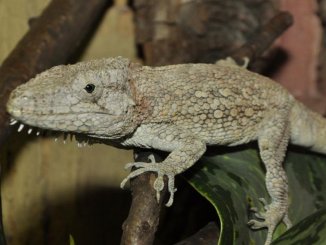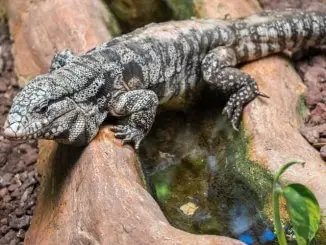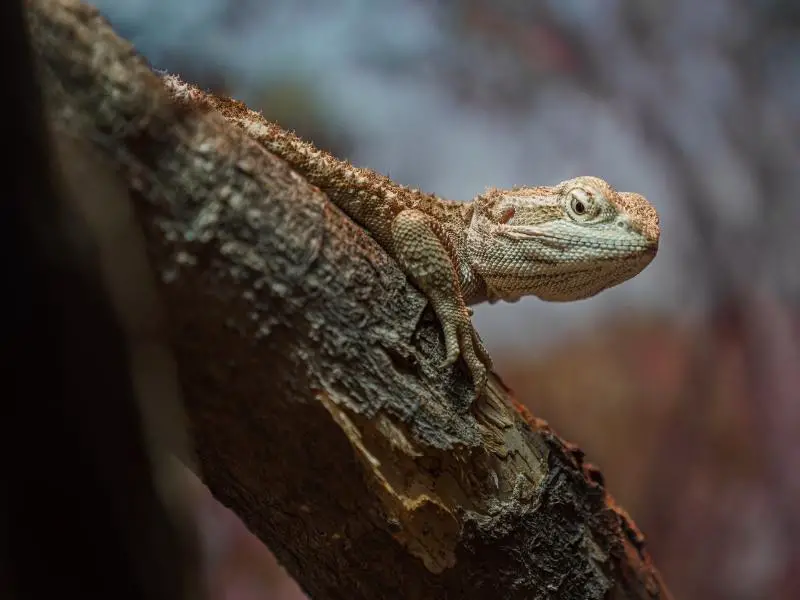
The rankin’s dragon is a small, semi-arboreal species of lizard endemic to Queensland in Australia. Rankin’s dragons make great pets and are known for their peaceful natures, playful behaviors, and tolerance of handling.
The rankin’s dragon is fairly easy to care for and lives for up to eight years in captivity.
Rankin’s Dragon Overview
| Common name | Rankin’s dragon, rankins dragon, pygmy bearded dragon, black-soiled bearded dragon, Lawson’s dragon, dwarf bearded dragon, dumpy dragon |
| Scientific name | Pogona henrylawsoni |
| Natural habitat | Queensland Australia, dry, arid, warm areas, rocks |
| Adult size | Up to 12 inches |
| Average lifespan | Up to 8 years |
| Diet | Omnivore |
| Housing | 4 x 2 x 2 ft vivarium or larger, UVB lighting, basking spot, shady spot, hides, 82–110°F thermal gradient, 30–40% humidity, 12 hour photoperiod, completely dark in evening |
| Experience | Beginner |
Origin
Rankin’s dragons are native to Queensland in Australia, where they inhabit arid, rocky, and warm scrublands. These lizards are diurnal and enjoy basking in the sun. While rare in the pet trade, rankin’s dragons are relatively common in their wild habitat and aren’t considered an endangered species.
The rankin’s dragon, formally known as Pogona henrylawsoni, was named after Australian poet and author Henry Lawson.
Appearance and Behavior
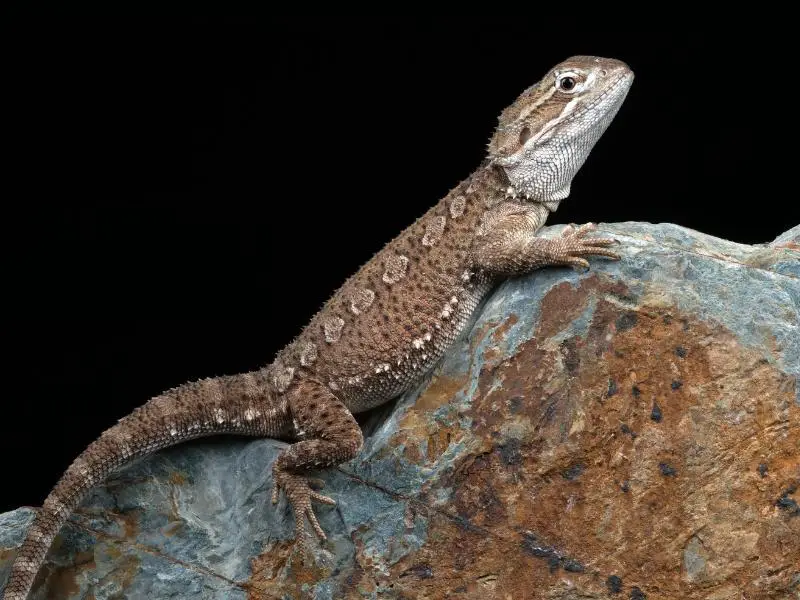
The rankin’s dragon is a small lizard species with a round head, short snout, and slender body that comes in different shades of brown and gray. Rankin’s dragons are spiky and have a unique, bowtie marking that spans across their back.
Rankin’s dragons are closely related to central bearded dragons (Pogona vitticeps). While similar in appearance, rankin’s dragons are smaller and have shorter lifespans than central bearded dragons. Rankin’s dragons also lack the prominent beard and can happily cohabitate.
Males typically have larger heads and thicker tails than females. However, the most accurate way to sex a rankin’s dragon is to look underneath its tail. Males have two lumps (hemipenal bulges) at their tail’s base, while females have a singular bulge.
All pygmy bearded dragons possess striking eyes, rough skin, and sharp claws that allow them to grip onto rough surfaces like trees and rocks. When threatened, these lizards often hide in foliage, caves, or cracks within the substrate.
Size and Lifespan
The rankin’s dragon is one of the smallest species in the genus pogona, with a maximum tail-to-head length of 12 inches and weight under one pound. Females and males are similar in size.
Rankin’s dragons live for up to eight years in captivity. Provide a protein-rich diet, thermal gradient, and UVB bulb to give these lizards the best chances of survival.
Temperament
The rankin’s dragon is a docile, even-tempered species that spends most of its time basking in the sun, climbing, and hiding within cracks or burrows. These lizards are also sociable and get along well with their own kind. Ensure females outnumber males when housing multiple rankin’s dragons.
While rarely aggressive and tolerant of handling, the rankin’s dragon may bite if it feels threatened. However, the bite isn’t lethal and is relatively painful, equivalent to a small, tingling pinch.
Rankin’s dragons exhibit various playful and captivating behaviors, including head bobbing and arm waving. This species is most active during the day.
Housing Rankins Dragons
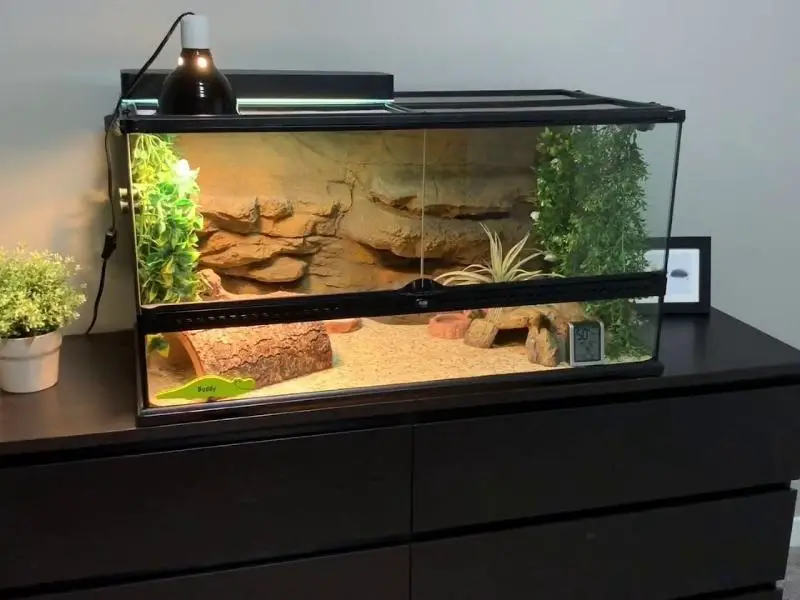
In the wild, the rankin’s dragon lives in the arid, rocky, and hot regions of Queensland, Australia. Mimic the lizard’s natural habitat in the enclosure to allow it to engage in its natural behaviors and live a long, happy life.
Keep the rankin’s dragon in a spacious vivarium.
Enclosure size
Rankin’s dragons require a 4 x 2 x 2 ft vivarium or larger with enough width and height to accommodate a thermal gradient, thick substrate, and climbing materials like branches and rocks. Juveniles should be kept in 15-gallon tanks.
Lighting
Rankin’s dragons need UVB lighting for vitamin D3 synthesis, a process that allows them to properly absorb and use calcium.
Add a 10 to 12% UVB light tube that spans across two thirds of the enclosure. Keep the light on for 12 hours per day — with total darkness in the evening — to simulate a natural day-to-night cycle. Ensure the UVB is mounted underneath the tank lid and replace the bulb every 6 to 12 months.
A basking lamp should also be added at one end of the pygmy bearded dragon’s enclosure.
Temperature and Humidity
The rankin’s dragon requires a temperature gradient, meaning a hot and cool end in the enclosure, to regulate its internal body temperature. The warm end of the enclosure must stay between 110 and 110°F, while the cool end should be around 82°F. The temperature can safely drop to around 75°F at night.
Place thermometers at both sides and take readings daily to ensure fluctuations are kept to a minimum. If the basking lamp isn’t generating enough heat, add a ceramic heat emitter, though ensure heat sources can’t come in direct contact with the lizard’s skin.
Rankin’s dragons are accustomed to arid climates and prefer a low humidity level of 30 to 40%. Cross-ventilation and a dry substrate helps maintain low humidity. However, if the humidity level falls below 30%, lightly mist the enclosure with water.
Check the humidity level each day with a hygrometer. Improper humidity levels can cause health issues like respiratory infections, mouth rot, and excessive shedding.
Substrate and Decoration
Replace the rankin’s dragon’s natural habitat with rocks, smooth stones, branches, logs, and vegetation. Ensure decorations are non-abrasive and scattered throughout the enclosure.
Hiding spots help these lizards feel safe and provide shelter from the heat and light. Create hiding spots with caves, plant pots, and dense foliage, though don’t overcrowd the vivarium. Use sturdy live plants that are easy to climb and can withstand high temperatures.
Suitable substrates include slate tiles, reptile carpet, newspaper, and paper towels. Slate tiles are particularly ideal because they retain heat well and help rankin’s dragons wear down their claws.
Don’t use substrate materials that retain moisture or can cause impaction (intestinal blockage) if swallowed. Also avoid substrates that are difficult to clean or encourage mold growth, like alfalfa pellets.
Add a sturdy, tip-proof water bowl for the rankin’s dragon to drink from and bathe in.
Cleaning
Spot clean the rankin’s dragon vivarium each day. Discard leftover food and waste, top up the bowl with fresh water, and clear away dirtied substrate. Thoroughly rinse the water bowl if there’s waste or debris inside it.
Perform a deep clean every month to prevent harmful mold and bacteria growth. Remove the substrate, decorations, and foliage, and then wash everything down, including the enclosure walls, with warm, soapy water. Don’t use soap with added fragrances. A bristled brush can help tackle dirty crevices and stains, though be careful not to scratch the enclosure’s glass.
Rinse well and leave everything to dry before replacing the substrate and returning the decorations.
Transfer the rankin’s dragon to a temporary enclosure while cleaning. Ensure the separate vivarium is warm, clean, and has plenty of hiding spots.
Rankins Dragon Care
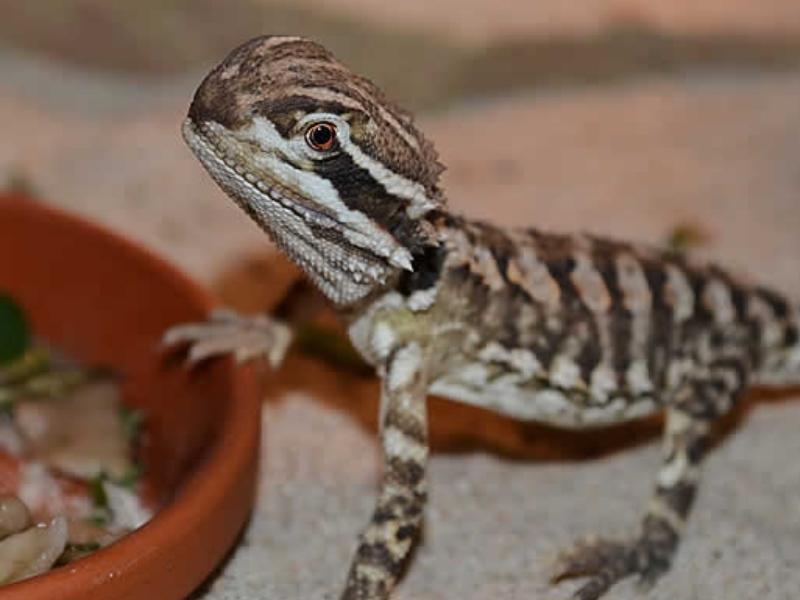
The rankin’s dragon is easy to care for because of its even-tempered nature, small size, and flexible diet. However, proper husbandry is vital to prevent health issues like metabolic bone disorder.
Food and Water
Rankin’s dragons are omnivores that feed on a wide variety of insects and vegetables in the wild. Replace the lizard’s varied diet in captivity with crickets, dubia roaches, locusts, mealworms, morio worms, leafy collard greens, and finely-chopped vegetables like carrots and squash.
Live foods, such as crickets, should be smaller or the same size as the space between the rankin’s dragon’s eyes. Clear away uneaten food to keep the enclosure clean.
Juvenile lizards should be fed daily, with a diet consisting of 80% insects and 20% greens, while adults should be fed three times a week on a diet of 20% insects and 80% greens. Juveniles require more protein because their bodies are still developing.
Supplement the rankin’s dragon diet with multivitamins and calcium powder. Dust onto the lizard’s food two times a week, or more frequently if the lizard is young. Also ensure the bearded dragon always has access to fresh, clean water. The water bowl should be sturdy, shallow, and positioned at the cool end of the enclosure to lessen its impact on humidity levels.
Rankin’s dragons aren’t picky eaters. However, don’t feed these lizards vegetables that are vitamin-deficient, moisture-rich, or acidic, such as iceberg lettuce, spinach, and onions.
Handling
Rankin’s dragons are docile, sociable, and rarely aggressive. With proper acclimatization, these lizards are extremely tolerant of handling.
Handle the rankin’s dragon from a young age, gradually increasing the duration of contact, to get the lizard accustomed to being touched. Always wash your hands before and after handling to prevent disease transmission and the spread of harmful bacteria like salmonella.
Don’t pick the rankin’s dragon up by its tail, head, or legs. Instead, gently scoop up the lizard while supporting its full weight and rest it against your chest. Always use slow, predictable movements.
Rankin’s dragons need high temperatures to survive, so don’t keep these lizards outside of their enclosure for longer than 20 minutes. Also avoid handling rankin’s dragons if they’re stressed, sick, hungry, or shedding.
Common Health Issues
Rankin’s dragons are relatively healthy and live for six to eight years on average. However, these lizards are susceptible to common reptile health issues like metabolic bone disorder, respiratory infections, mouth rot, and impaction.
Metabolic Bone Disorder (MBD)
A calcium to phosphorus imbalance that causes weakened, damaged bones. Symptoms include bone fractures, weight loss, appetite loss, lameness, uncoordinated movements, leg abnormalities, a swollen, softened jaw, and an arched spine.
Treatment depends on the severity of the condition, though it typically involves dietary changes, stronger calcium and vitamin supplements, and high-intensity UVB lighting.
Mouth Rot (Stomatitis)
A bacterial infection that affects the lizard’s gums and jaw. Symptoms include appetite loss, inflamed or decaying oral tissue, swollen gums, a thick mucus, and excessive drainage from the mouth or nose. Without timely intervention, mouth rot can spread and affect the lizard’s lungs, causing pneumonia.
Treatment involves antibiotics and washing the lizard’s mouth with antiseptic. Damaged oral tissue may require surgery. Mouth rot can be prevented with ideal enclosure conditions, a well-balanced, nutritious diet, and ensuring decorations aren’t abrasive.
Respiratory infections
An infection, caused by fungi, bacteria, parasites, or virus, that attacks and hinders the lizard’s lungs. Symptoms include nasal discharge, lethargy, shallow, rapid breathing, open mouth breathing, and weight loss.
Infected lizards should receive veterinary care. Medication will be prescribed depending on the cause of the infection. The enclosure should also be kept warm, ideally at the upper end of the bearded dragon’s preferred temperature range.
Impaction
When the bearded dragon’s intestines or gut becomes blocked. Symptoms of impaction include regurgitation, lameness, constipation, appetite loss, leg trembles, a swollen belly, and prominent bulge. Treatment involves a warm bath or drop of olive oil, and if symptoms persist, enema or surgery.
Like most reptile illnesses, impaction is associated with poor husbandry. If the lizard doesn’t receive enough nutrients and vitamins, it may resort to feeding on substrate and debris instead, both of which can’t be digested easily and greatly increase the risk of impaction.
Shedding
Signs a rankin’s dragon is about to undergo shedding include tight skin, dull or white coloration, lethargy, and appetite loss. Don’t forcibly peel off the shedding skin as this can cause severe pain and put the lizard at risk of infections.
Adult rankin’s dragons shed a few times per year, while juveniles shed every few weeks.
Lightly mist the vivarium to ensure there’s enough moisture in the air for the lizard to shed with ease.
Breeding
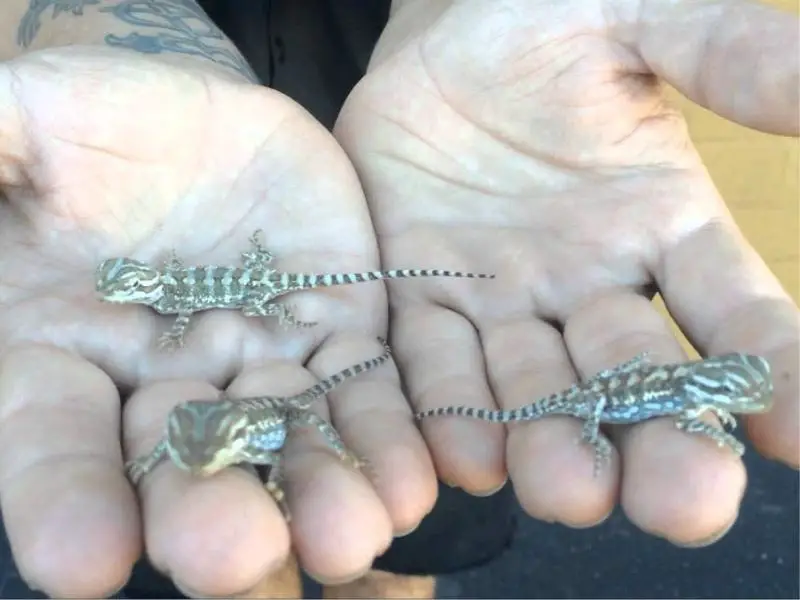
Male and female rankin’s dragons readily breed in ideal enclosure conditions. Breeding can occur when the lizards are at least 18 months old and have undergone brumation.
The male will exhibit courting behaviors — like head bobbing, arm waving, open mouth breathing, and feet stomping — then mount the female and insert his hemipenes (reproductive organs) into her cloaca. The mating process is quick and typically lasts for a few minutes.
After mating, add a nesting box — a safe, 10-gallon container where the female can lay her eggs — at one end of the enclosure. Keep the box humid with a warm, moisture-rich substrate like damp soil. A gravid female will lay a clutch of around 15 to 24 eggs within a few months.
Remove the eggs and keep them incubated in a container, at a temperature between 82 and 86°F and humidity of 80%, for up to 70 days. Newly-hatched rankin’s dragons should be kept in small tanks and fed a protein-rich diet to support their growth.
Choosing and Buying a Rankins Dragon
Rankin’s dragons cost between $100 and $400. These lizards aren’t readily available in pet stores and can typically only be found online, at expos, or through private breeders. Price can vary depending on size, age, and breeder.
Buying from a reputable breeder, while expensive, is the safest option as the lizard is much more likely to be healthy and well-acclimatized. A healthy rankin’s dragon is active and sociable with good coloration. Don’t buy lizards that are thin, lethargic, or have dull eyes.


